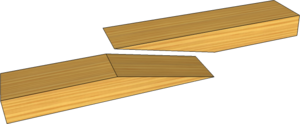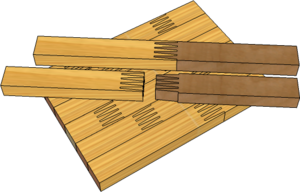Scarf Joint
From DT Online
Scarf Joints are Lengthening Joints used to join pieces of timber end to end. Timber often has to be lengthened in big projects such as garages, carports or floor renovation and, occasionally, it may be necessary to insert a length of timber when repairing or restoring furniture.
When compared with the timbers they are joining, most Scarf Joints are weak and when used in construction often need strengthening by bolting additional Fish Plates on either side or fixing metal straps around them. Also, if timbers have to be joined to make a garden Pergola for example, it is good practice to make the joint over a supporting pillar.
- Plain Scarf
The joining pieces are simply cut to a shallow angle and glued together. It is a weak joint, suitable only for repair and patching work in furniture, but if care is taken to match the grain, the finished repair will be hardly noticeable.
- Scarf with Nibs
If small shoulders or Nibs are added these provide a positive stop at the end of the joint. This may improve performance in Compression but will not improve Bending Strength and if exposed to such, the joint would need additional reinforcement.
- Hooked Scarf with Nibs
To improve performance in Tension, Hooks can be added as shown but, again, if exposed to Bending, the joint would need additional reinforcement.
- Keylocked Hooked Scarf with Nibs
Keys or wedges can be added to tighten joints (with or without Hooks) on assembly and will stop the joints loosening, but they do not add greatly to their strength.
- Scarf Joint Reinforcement
Scarf Joints may be Nailed, Screwed, or Bolted through but the addition of Fish Plates may be required for extra strength.
Several standard wood joints can also be used as Lengthening Joints in a Scarf Joint configuration (e.g. Halving Joint, Dovetail Joint, Bridle Joint) as shown).
Modern practice, arising from the need to preserve timber resources and made possible by modern tooling and adhesives, is to use Tapered Finger Joints extensively to join random lengths of timber stock together and to further combine these strips into wide boards (e.g. for table tops).






